Comparing Patent and Scientific Literature in Airborne Wind Energy
Abstract
:1. Introduction
2. Theoretical Framework
3. Materials and Methods
4. Results and Discussion
5. Conclusions
Acknowledgments
Author Contributions
Conflicts of Interest
References
- Goldemberg, J.; Lucon, O. Energia e meio ambiente no Brasil. Estud. Av. 2007, 21, 7–20. [Google Scholar] [CrossRef]
- Loyd, M.L. Crosswind kite power. J. Energy 1980, 4, 106–111. [Google Scholar] [CrossRef]
- Diehl, M. Airborne wind energy: Basic concepts and physical foundations. In Airborne Wind Energy; Springer: Berlin/Heidelberg, Germany, 2013; pp. 3–22. [Google Scholar]
- De Oliveira, M.D.L.C. Airborne Wind Energy With Tethered Wings: Modeling, Analysis and Control. Ph.D. Thesis, Federal University of Santa Catarina, Florianopolis, Brazil, 2016. [Google Scholar]
- De Lellis, M.; Mendonça, A.K.; Saraiva, R.; Trofino, A.; Lezana, Á. Electric power generation in wind farms with pumping kites: An economical analysis. Renew. Energy 2016, 86, 163–172. [Google Scholar] [CrossRef]
- Ulian, C.L.; de Souza Mendonça, A.K.; Leusin, M.E.; Uriona Maldonado, M.; Lezana, A.G.R. Panorama da energia eólica: Contexto Brasileiro. In Empreendedorismo, Inovaçao e Sustentabilidade: Origem, Evolução e Tendências; Lezana, A.G.R., Ed.; UFSC: Florianapolis, Brasil, 2017; pp. 234–253. [Google Scholar]
- Fritz, F. Application of an automated kite system for ship propulsion and power generation. In Airborne Wind Energy; Springer: Berlin/Heidelberg, Germany, 2013; pp. 359–372. [Google Scholar]
- Milanese, M.; Taddei, F.; Milanese, S. Design and testing of a 60 kW yo-yo airborne wind energy generator. In Airborne Wind Energy; Springer: Berlin/Heidelberg, Germany, 2013; pp. 373–386. [Google Scholar]
- van der Vlugt, R.; Peschel, J.; Schmehl, R. Design and experimental characterization of a pumping kite power system. In Airborne Wind Energy; Springer: Berlin/Heidelberg, Germany, 2013; pp. 403–425. [Google Scholar]
- Bormann, A.; Ranneberg, M.; Kovesdi, P.; Gebhardt, C.; Skutnik, S. Development of a three-line ground-actuated airborne wind energy converter. In Airborne Wind Energy; Springer: Berlin/Heidelberg, Germany, 2014; pp. 427–436. [Google Scholar]
- Ruiterkamp, R.; Sieberling, S. Description and preliminary test results of a six degrees of freedom rigid wing pumping system. In Airborne Wind Energy; Springer: Berlin/Heidelberg, Germany, 2013; pp. 443–458. [Google Scholar]
- Vander Lind, D. Analysis and flight test validation of high performance airbornewind turbines. In Airborne Wind Energy; Springer: Berlin/Heidelberg, Germany, 2013; pp. 473–490. [Google Scholar]
- Hably, A.; Dumon, J.; Smith, G. Control of an airborne wind energy system with a Magnus effect. In Proceedings of the 2016 American Control Conference, Boston, MA, USA, 6–8 July 2016; IEEE: New York, NY, USA, 2016; pp. 4978–4983. [Google Scholar]
- Hably, A.; Lozano, R.; Alamir, M.; Dumon, J. Observer-based control of a tethered wing wind power system: Indoor real-time experiment. In Proceedings of the 2013 American Control Conference, Washington, DC, USA, 17–19 June 2013; IEEE: New York, NY, USA, 2013; pp. 3473–3478. [Google Scholar]
- Vermillion, C.; Glass, B.; Rein, A. Lighter-than-air wind energy systems. In Airborne Wind Energy; Springer: Berlin/Heidelberg, Germany, 2013; pp. 501–514. [Google Scholar]
- De Lellis, M.; Saraiva, R.; Trofino, A. Airborne Wind Energy—Automatic Flight Test; UFSCkite Project; Department of Automation and Systems, Federal University of Santa Catarina: Florianopolis, Brazil, 2016; Available online: http://trofino.das.ufsc.br/en/research/ufsckite (accessed on 30 May 2017).
- Albino, V.; Ardito, L.; Dangelico, R.M.; Petruzzelli, A.M. Understanding the development trends of low-carbon energy technologies: A patent analysis. Appl. Energy 2014, 135, 836–854. [Google Scholar] [CrossRef]
- Baron, J.; Pohlmann, T.; Blind, K. Essential patents and standard dynamics. Res. Policy 2016, 45, 1762–1773. [Google Scholar] [CrossRef]
- Ardito, L.; Petruzzelli, A.M.; Panniello, U. Unveiling the breakthrough potential of established technologies: An empirical investigation in the aerospace industry. Technol. Anal. Strateg. Manag. 2016, 28, 916–934. [Google Scholar] [CrossRef]
- Bessen, J. The value of US patents by owner and patent characteristics. Res. Policy 2008, 37, 932–945. [Google Scholar] [CrossRef]
- Ardito, L.; Petruzzelli, A.M.; Albino, V. Investigating the antecedents of general purpose technologies: A patent perspective in the green energy field. J. Eng. Technol. Manag. 2016, 39, 81–100. [Google Scholar] [CrossRef]
- Fagiano, L.; Milanese, M. Airborne Wind Energy: An overview. In Proceedings of the 2012 American Control Conference (ACC), Montreal, QC, Canada, 27–29 June 2012. [Google Scholar]
- Ahrens, U.; Diehl, M.; Schmehl, R. Airborne Wind Energy; Springer: Berlin/Heidelberg, Germany, 2013. [Google Scholar]
- Van Gries, A. Improvements in or Relating to Wind-Driven Power Apparatus. Application Number GB2081337A, 20 July 1938. [Google Scholar]
- Honnef, H. Wind Power Turbogenerator for High Altitude Wind Utilization; National Aeronautics and Space Administration: Washington, DC, USA, 1974. [Google Scholar]
- Honnef, H. High Wind Power Plants; Technical Translation NASA TT F-15, 444; National Aeronautics and Space Administration: Washington, DC, USA, 1974. [Google Scholar]
- Bote, D. Energie aus starken winden: Ausstellung des Hermann-Oberth-Raumfahrt Museums. Der Bote 2011, 1. [Google Scholar]
- Oberth, H. Primer For Those Who Would Govern; West-Art: New York, NY, USA, 1987. [Google Scholar]
- Kambouris, S. The Flying Electric Generator: Evaluating the Claims of a Largely Ignored Proposal for Generating Electricity from High-Altitude Winds. Master’s Thesis, School of Historical and Philosophical Studies School of Earth Sciences, The University of Melbourne, Melbourne, Australia, 2015. [Google Scholar]
- Schmehl, R. Airborne Wind Energy Conference: Book of Abstracts; Faculty of Aerospace Engineering-Delft University of Technology: Delft, The Netherlands, 2015. [Google Scholar]
- Gil, A.C. Métodos e técnicas de pesquisa social. In Como Elaborar Projetos de Pesquisa, 4th ed.; Atlas: São Paulo, Brasil, 2002. [Google Scholar]
- Afonso, M.H.F.; de Souza, J.V.; Ensslin, S.R.; Ensslin, L. Como construir conhecimento sobre o tema de pesquisa? Aplicação do processo ProKnow-C na busca de literatura sobre avaliação do desenvolvimento sustentável. Rev. Gest. Soc. Ambien. 2012, 5, 47–62. [Google Scholar] [CrossRef]
- Uriona Maldonado, M.; Silva Santos, J.; Nonato Macedo dos Santos, R. Inovação e conhecimento organizacional: Um mapeamento bibliométrico das publicações cientificas até 2009. In Proceedings of the XXXIV Encontro da ANPAD, Rio de Janeiro, Brazil, 25–29 September 2010. [Google Scholar]
- Knutas, A.; Hajikhani, A.; Salminen, J.; Ikonen, J.; Porras, J. Cloud-based bibliometric analysis service for systematic mapping studies. In Proceedings of the 16th International Conference on Computer Systems and Technologies, Dublin, Ireland, 25–26 June 2015; ACM: New York, NY, USA, 2015. [Google Scholar]
- Van Eck, N.J.; Waltman, L. Software survey: VOSviewer, a computer program for bibliometric mapping. Scientometrics 2010, 84, 523–538. [Google Scholar] [CrossRef] [PubMed]
- Fletcher, C.A.J.; Roberts, B.W. Electricity-generation from jet-stream winds. J. Energy 1979, 3, 241–249. [Google Scholar] [CrossRef]
- Dai, C.; Dai, J. High-Altitude Wind Energy Combined Solar Generation Device, Has Balloon Connected with Pulling Rope That Is Connected with Kite Generating Device, Where Pulling Rope Is Fixedly Connected with Fixed Block. Application Number CN206017048-U, 15 March 2017. [Google Scholar]
- Ahrens, U.; Pieper, B.; Töpfer, C. Combining kites and rail technology into a traction-based airborne wind energy plant. In Airborne Wind Energy; Springer: Berlin/Heidelberg, Germany, 2013; pp. 437–441. [Google Scholar]
- Archer, C.L. An introduction to meteorology for airborne wind energy. In Airborne Wind Energy; Springer: Berlin/Heidelberg, Germany, 2013; pp. 81–94. [Google Scholar]
- Argatov, I.; Silvennoinen, R. Efficiency of traction power conversion based on crosswind motion. In Airborne Wind Energy; Springer: Berlin/Heidelberg, Germany, 2013; pp. 65–79. [Google Scholar]
- Bosch, A.; Schmehl, R.; Tiso, P.; Rixen, D. Nonlinear aeroelasticity, flight dynamics and control of a flexible membrane traction kite. In Airborne Wind Energy; Springer: Berlin/Heidelberg, Germany, 2013; pp. 307–323. [Google Scholar]
- Bosman, R.; Reid, V.; Vlasblom, M.; Smeets, P. Airborne wind energy tethers with high-modulus polyethylene fibers. In Airborne Wind Energy; Springer: Berlin/Heidelberg, Germany, 2013; pp. 563–585. [Google Scholar]
- Breukels, J.; Schmehl, R.; Ockels, W. Aeroelastic simulation of flexible membrane wings based on multibody system dynamics. In Airborne Wind Energy; Springer: Berlin/Heidelberg, Germany, 2013; pp. 287–305. [Google Scholar]
- Coleman, J.; Ahmad, H.; Pican, E.; Toal, D. Non-reversing generators in a novel design for pumping mode airbornewind energy farm. In Airborne Wind Energy; Springer: Berlin/Heidelberg, Germany, 2013; pp. 587–597. [Google Scholar]
- Dunker, S. Ram-air wing design considerations for airborne wind energy. In Airborne Wind Energy; Springer: Berlin/Heidelberg, Germany, 2013; pp. 517–546. [Google Scholar]
- Erhard, M.; Strauch, H. Theory and experimental validation of a simple comprehensible model of tethered kite dynamics used for controller design. In Airborne Wind Energy; Springer: Berlin/Heidelberg, Germany, 2013; pp. 141–165. [Google Scholar]
- Fagiano, L.; Zgraggen, A.U.; Morari, M. On modeling, filtering and automatic control of flexible tethered wings for airborne wind energy. In Airborne Wind Energy; Springer: Berlin/Heidelberg, Germany, 2013; pp. 167–180. [Google Scholar]
- Fechner, U.; Schmehl, R. Model-based efficiency analysis of wind power conversion by a pumping kite power system. In Airborne Wind Energy; Springer: Berlin/Heidelberg, Germany, 2013; pp. 249–269. [Google Scholar]
- Geebelen, K.; Vukov, M.; Zanon, M.; Gros, S.; Wagner, A.; Diehl, M.; Vandepitte, D.; Swevers, J.; Ahmad, H. An Experimental Test Setup for Advanced Estimation and Control of an AirborneWind Energy System. In Airborne Wind Energy; Springer: Berlin/Heidelberg, Germany, 2013; pp. 459–471. [Google Scholar]
- Gohl, F.; Luchsinger, R.H. Simulation based wing design for kite power. In Airborne Wind Energy; Springer: Berlin/Heidelberg, Germany, 2013; pp. 325–338. [Google Scholar]
- Goldstein, L. Airborne wind energy conversion systems with ultra high speed mechanical power transfer. In Airborne Wind Energy; Springer: Berlin/Heidelberg, Germany, 2013; pp. 235–247. [Google Scholar]
- Gros, S.; Diehl, M. Modeling of airborne wind energy systems in natural coordinates. In Airborne Wind Energy; Springer: Berlin/Heidelberg, Germany, 2013; pp. 181–203. [Google Scholar]
- Heilmann, J.; Houle, C. Economics of pumping kite generators. In Airborne Wind Energy; Springer: Berlin/Heidelberg, Germany, 2013; pp. 271–284. [Google Scholar]
- Horn, G.; Gros, S.; Diehl, M. Numerical trajectory optimization for Airborne Wind Energy systems described by high fidelity aircraft models. In Airborne Wind Energy; Springer: Berlin/Heidelberg, Germany, 2013; pp. 205–218. [Google Scholar]
- Leloup, R.; Roncin, K.; Bles, G.; Leroux, J.-B.; Jochum, C.; Parlier, Y. Estimation of the lift-to-drag ratio using the lifting line method: Application to a leading edge inflatable kite. In Airborne Wind Energy; Springer: Berlin/Heidelberg, Germany, 2013; pp. 339–355. [Google Scholar]
- Luchsinger, R.H. Pumping cycle kite power. In Airborne Wind Energy; Springer: Berlin/Heidelberg, Germany, 2013; pp. 47–64. [Google Scholar]
- Maaß, J.; Erhard, M. Software system architecture for control of tethered kites. In Airborne Wind Energy; Springer: Berlin/Heidelberg, Germany, 2013; pp. 599–611. [Google Scholar]
- Olinger, D.J.; Goela, J.S.; Tryggvason, G. Modeling and testing of a kite-powered water pump. In Airborne Wind Energy; Springer: Berlin/Heidelberg, Germany, 2013; pp. 387–401. [Google Scholar]
- Paulig, X.; Bungart, M.; Specht, B. Conceptual design of textile kites considering overall system performance. In Airborne Wind Energy; Springer: Berlin/Heidelberg, Germany, 2013; pp. 547–562. [Google Scholar]
- Penedo, R.J.; Pardal, T.C.; Silva, P.M.S.; Fernandes, N.M.; Fernandes, T.R.C. High altitude wind energy from a hybrid lighter-than-air platform using the magnus effect. In Airborne Wind Energy; Springer: Berlin/Heidelberg, Germany, 2013; pp. 491–500. [Google Scholar]
- Schmehl, R.; Noom, M.; van der Vlugt, R. Traction power generation with tethered wings. In Airborne Wind Energy; Springer: Berlin/Heidelberg, Germany, 2013; pp. 23–45. [Google Scholar]
- Schmidt, W.; Anderson, W. Kites: Pioneers of atmospheric research. In Airborne Wind Energy; Springer: Berlin/Heidelberg, Germany, 2013; pp. 95–116. [Google Scholar]
- Zanon, M.; Gros, S.; Diehl, M. Model predictive control of rigid-airfoil airborne wind energy systems. In Airborne Wind Energy; Springer: Berlin/Heidelberg, Germany, 2013; pp. 219–233. [Google Scholar]
- Zillmann, U.; Hach, S. Financing strategies for airborne wind energy. In Airborne Wind Energy; Springer: Berlin/Heidelberg, Germany, 2013; pp. 117–137. [Google Scholar]
- Canale, M.; Fagiano, L.; Milanese, M. High altitude wind energy generation using controlled power kites. IEEE Trans. Control Syst. Technol. 2010, 18, 279–293. [Google Scholar] [CrossRef]
- Houska, B.; Diehl, M. Optimal control for power generating kites. In Proceedings of the 2007 European Control Conference (ECC), Kos, Greece, 2–5 July 2007. [Google Scholar]
- Williams, P.; Lansdorp, B.; Ockels, W. Optimal crosswind towing and power generation with tethered kites. J. Guid. Control Dyn. 2008, 31, 81–93. [Google Scholar] [CrossRef]
- Archer, C.L.; Caldeira, K. Global assessment of high-altitude wind power. Energies 2009, 2, 307–319. [Google Scholar] [CrossRef]
- Vander Lind, D. Kite configuration and flight strategy for flight in high wind speeds. U.S. Patent 8922046 B2, 30 December 2014. [Google Scholar]
- Vander Lind, D. Kite Ground Station and System Using Same. U.S. Patent 8888049 B2, 18 November 2014. [Google Scholar]
- Vander Lind, D. Planform Configuration for Stability of a Powered Kite and a System and Method for Use of Same. U.S. Patent 8800931 B2, 12 August 2014. [Google Scholar]
- Carpenter, H.G. Tethered Aircraft System for Gathering Energy from Wind. U.S. Patent 6254034 B1, 3 July 2001. [Google Scholar]
- Vander Lind, D.; Van Niekerk, B.; Hardham, C. Tethered System for Power Generation. U.S. Patent 20100295303 A1, 25 November 2010. [Google Scholar]

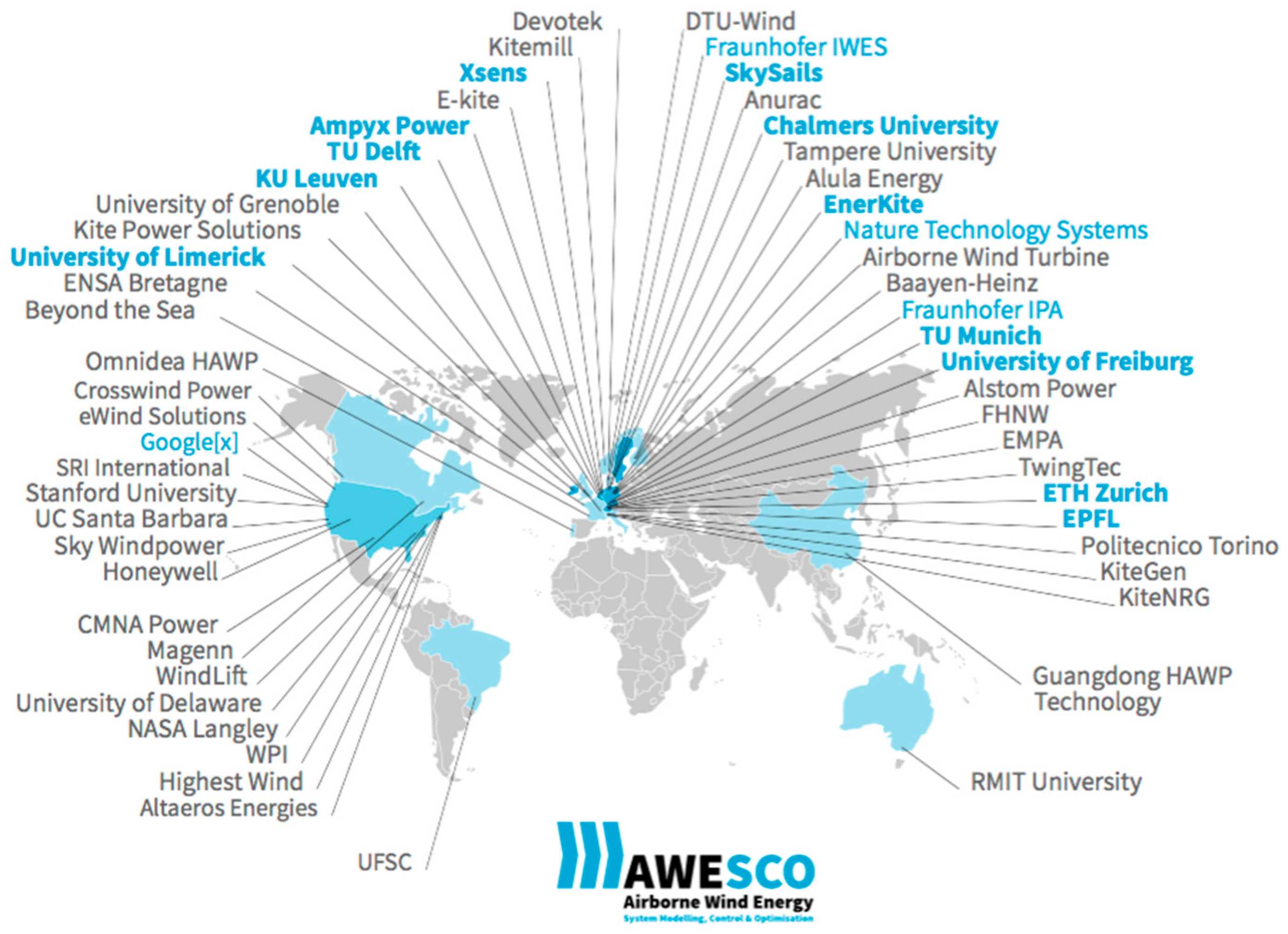
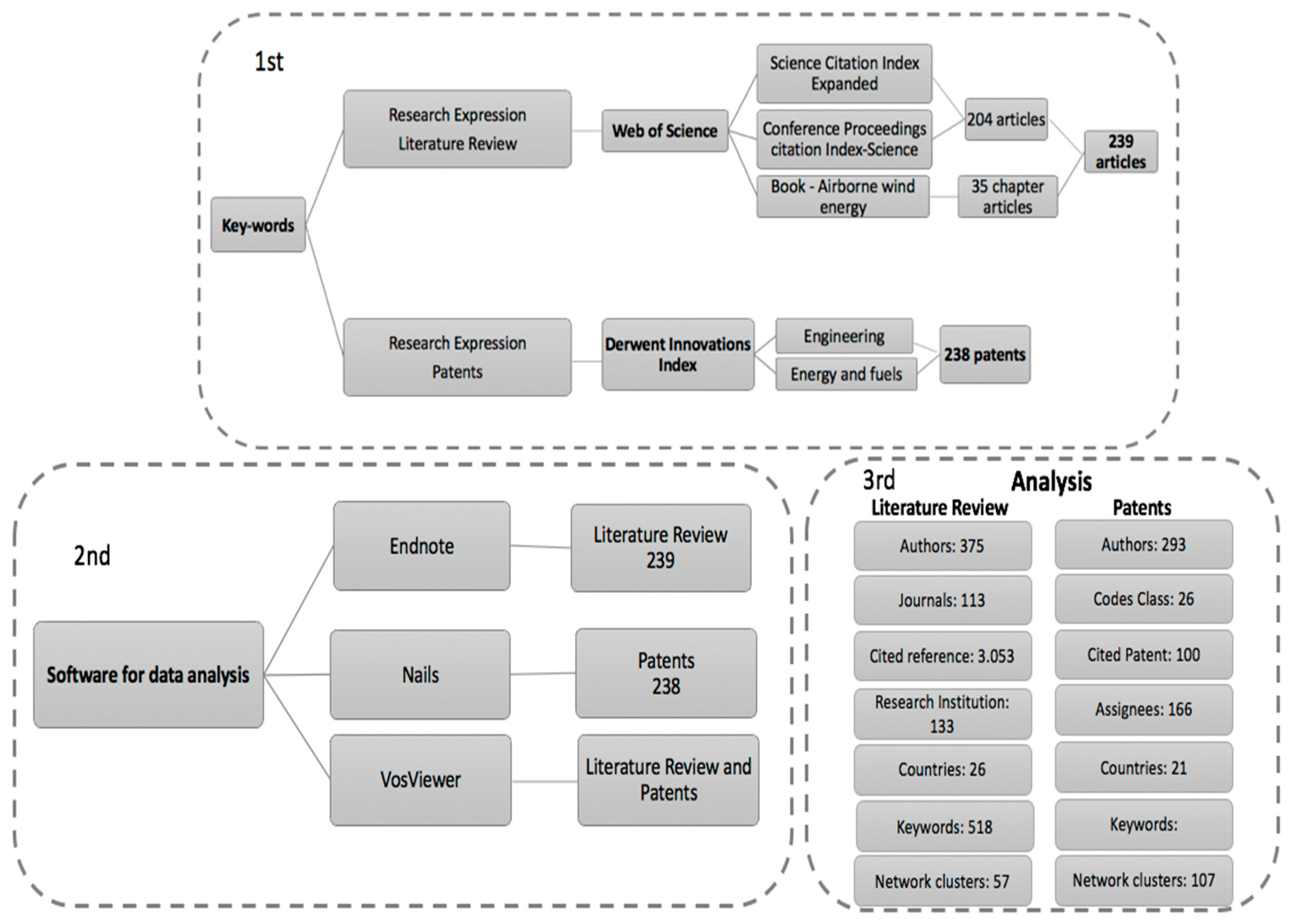
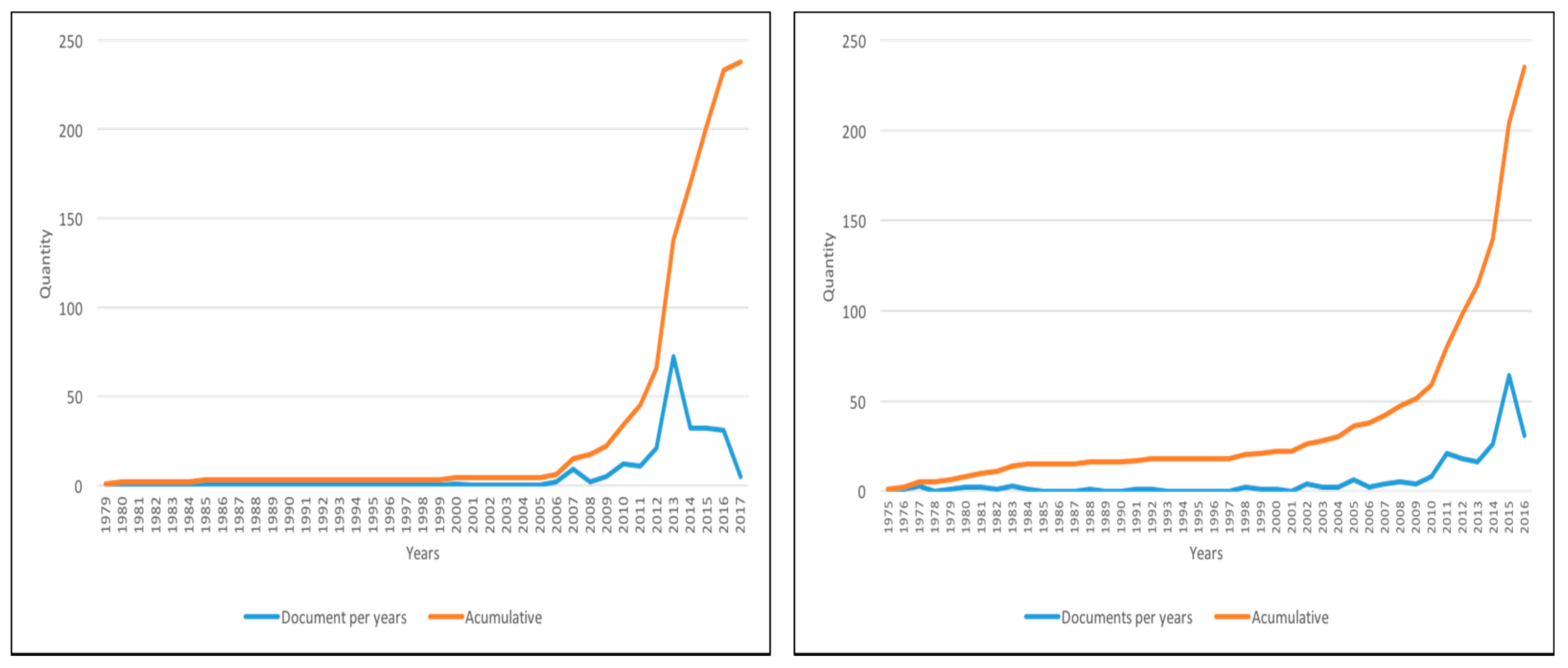
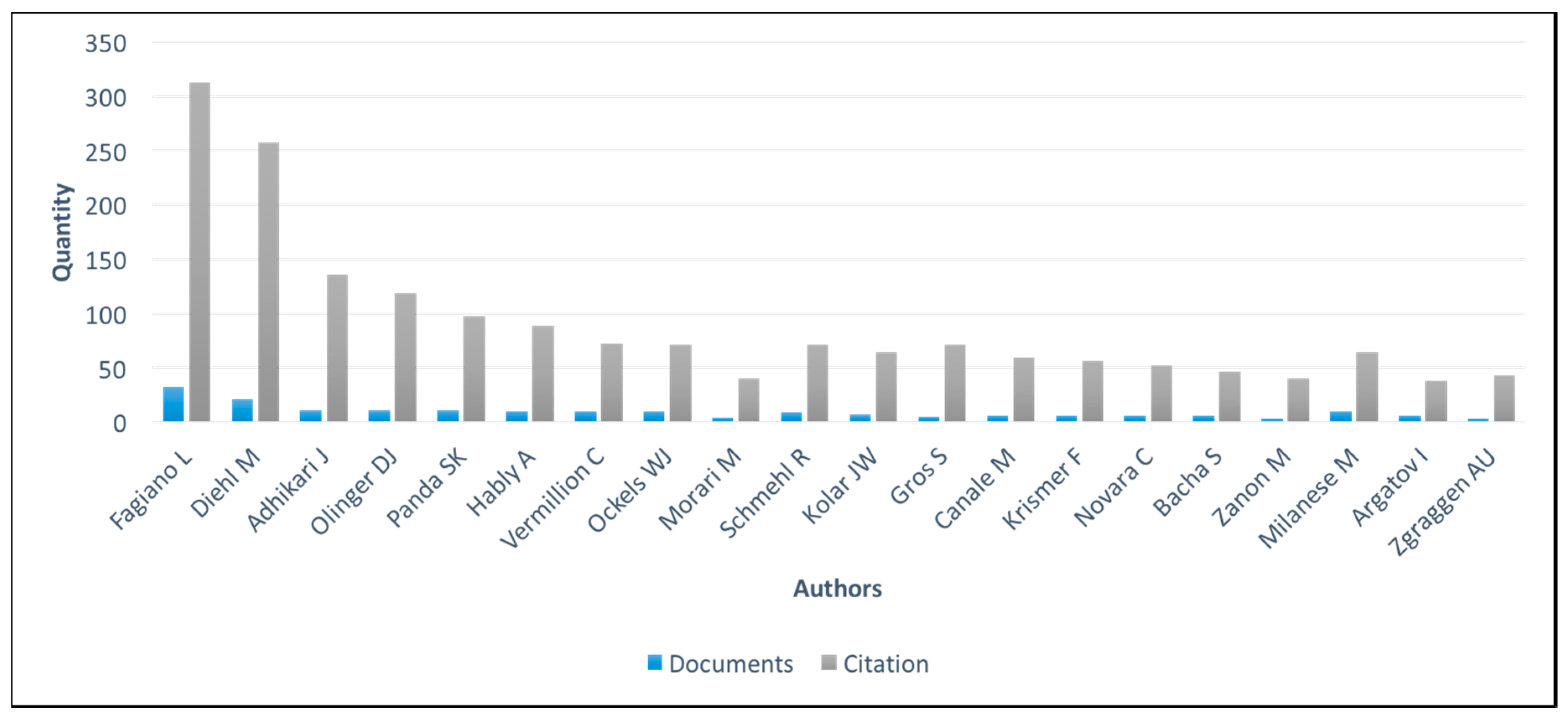
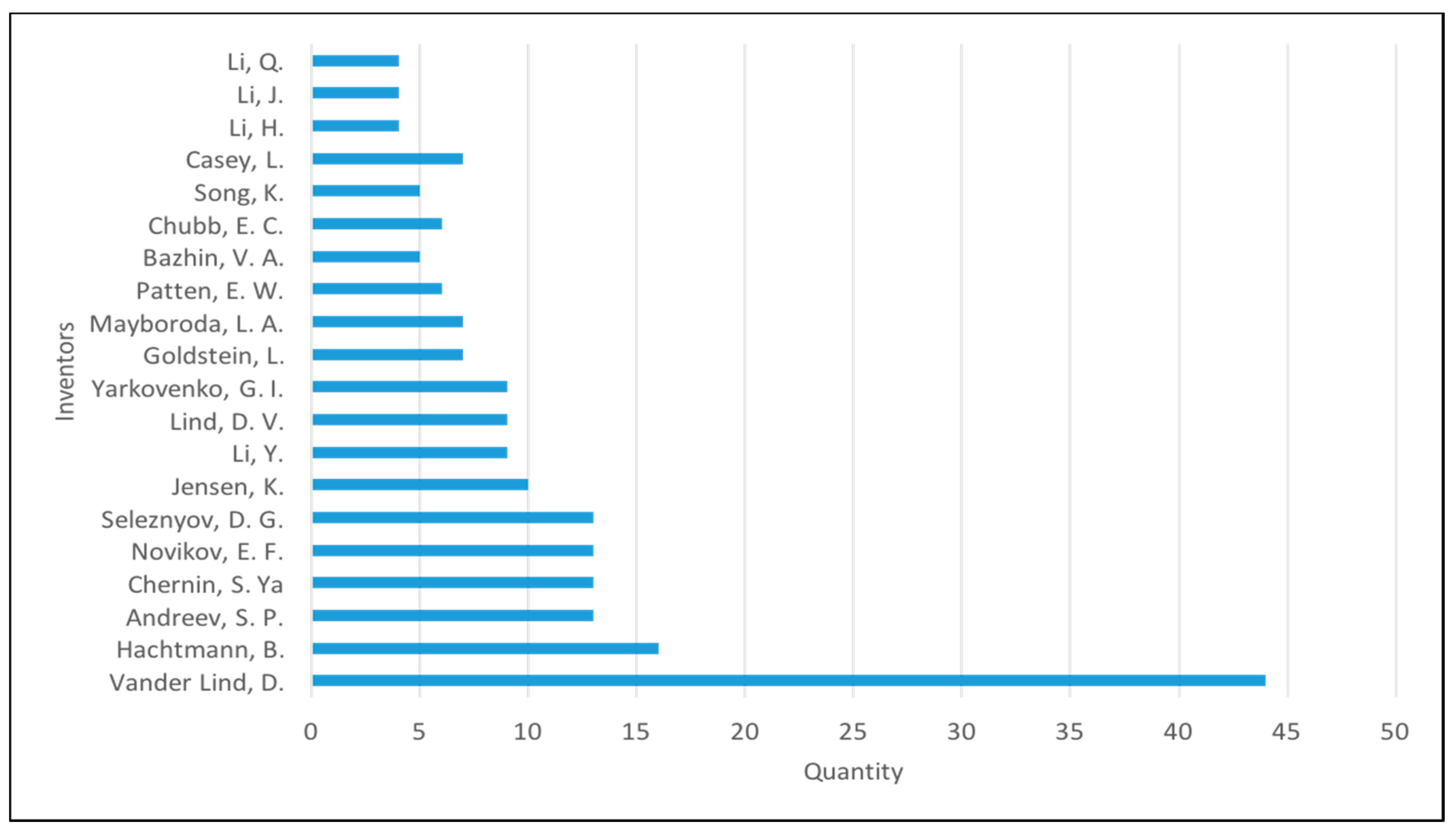
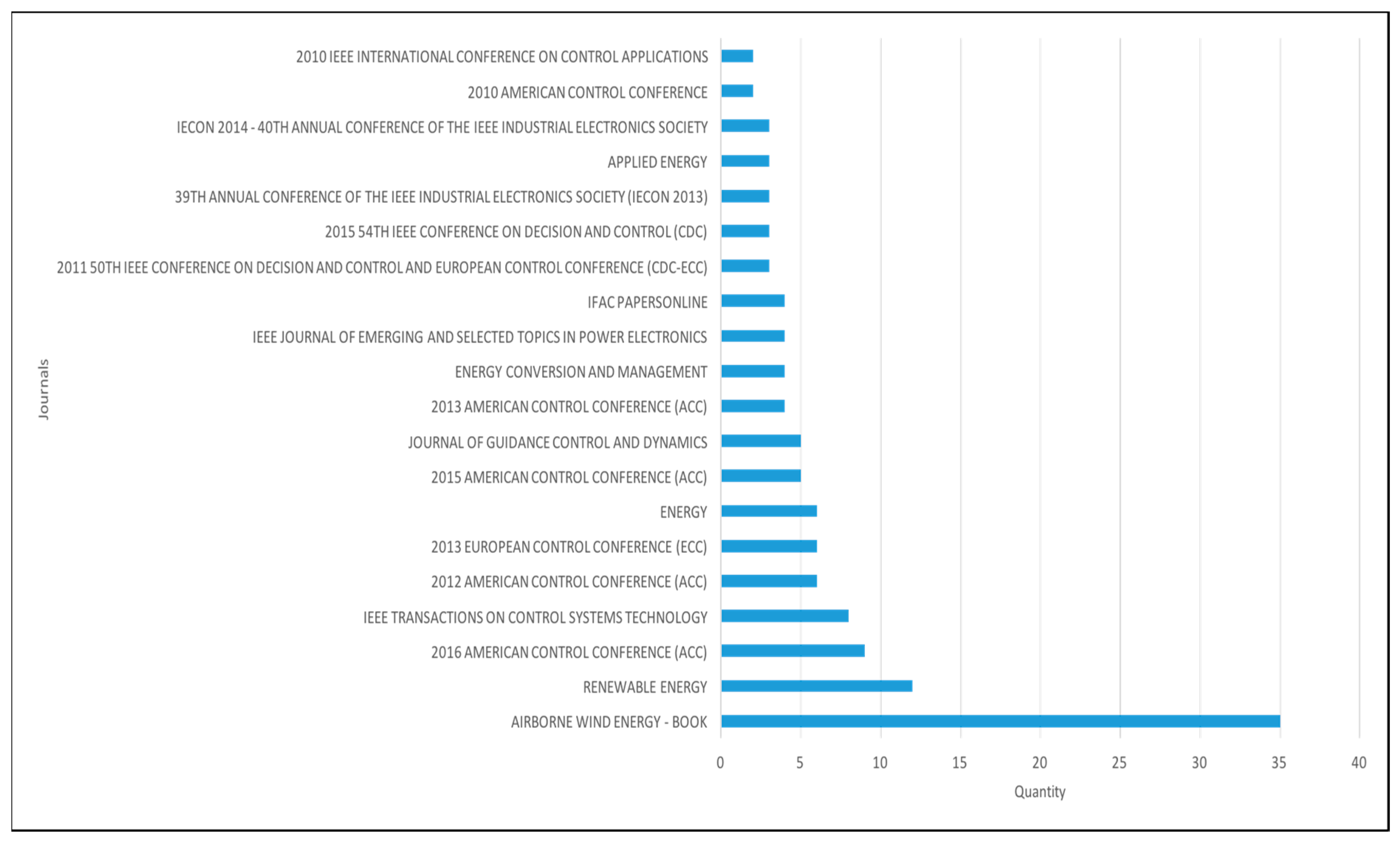

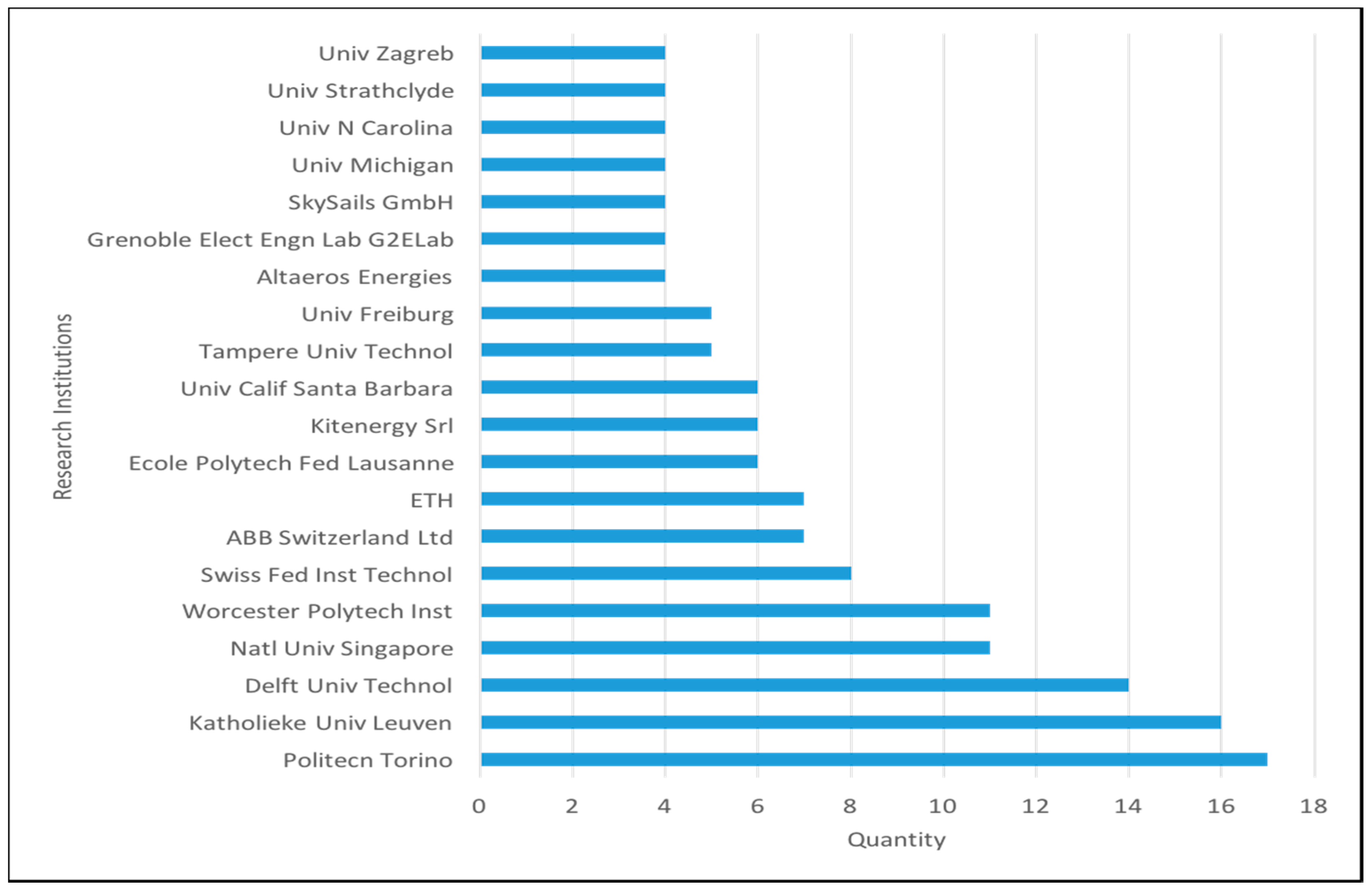
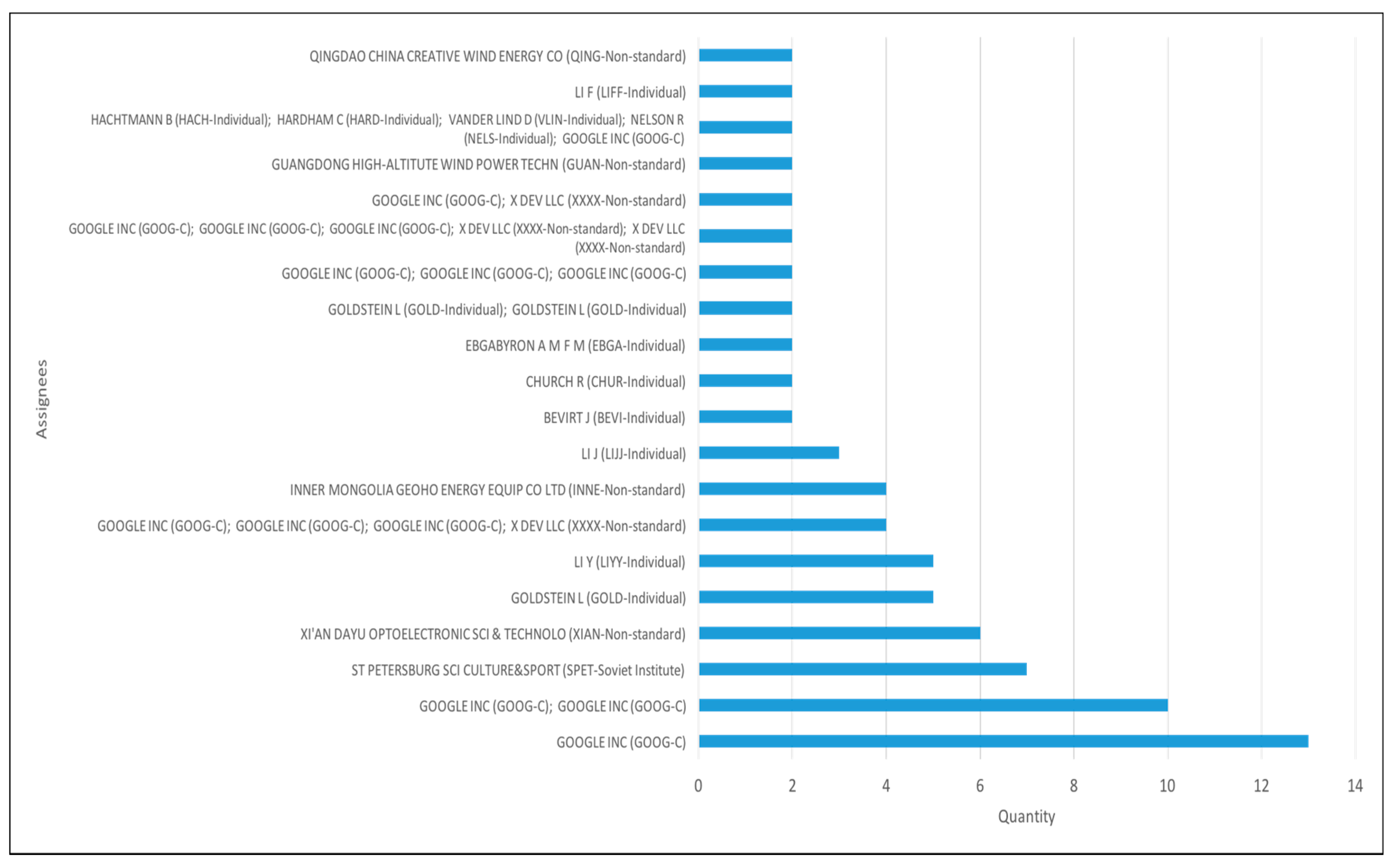


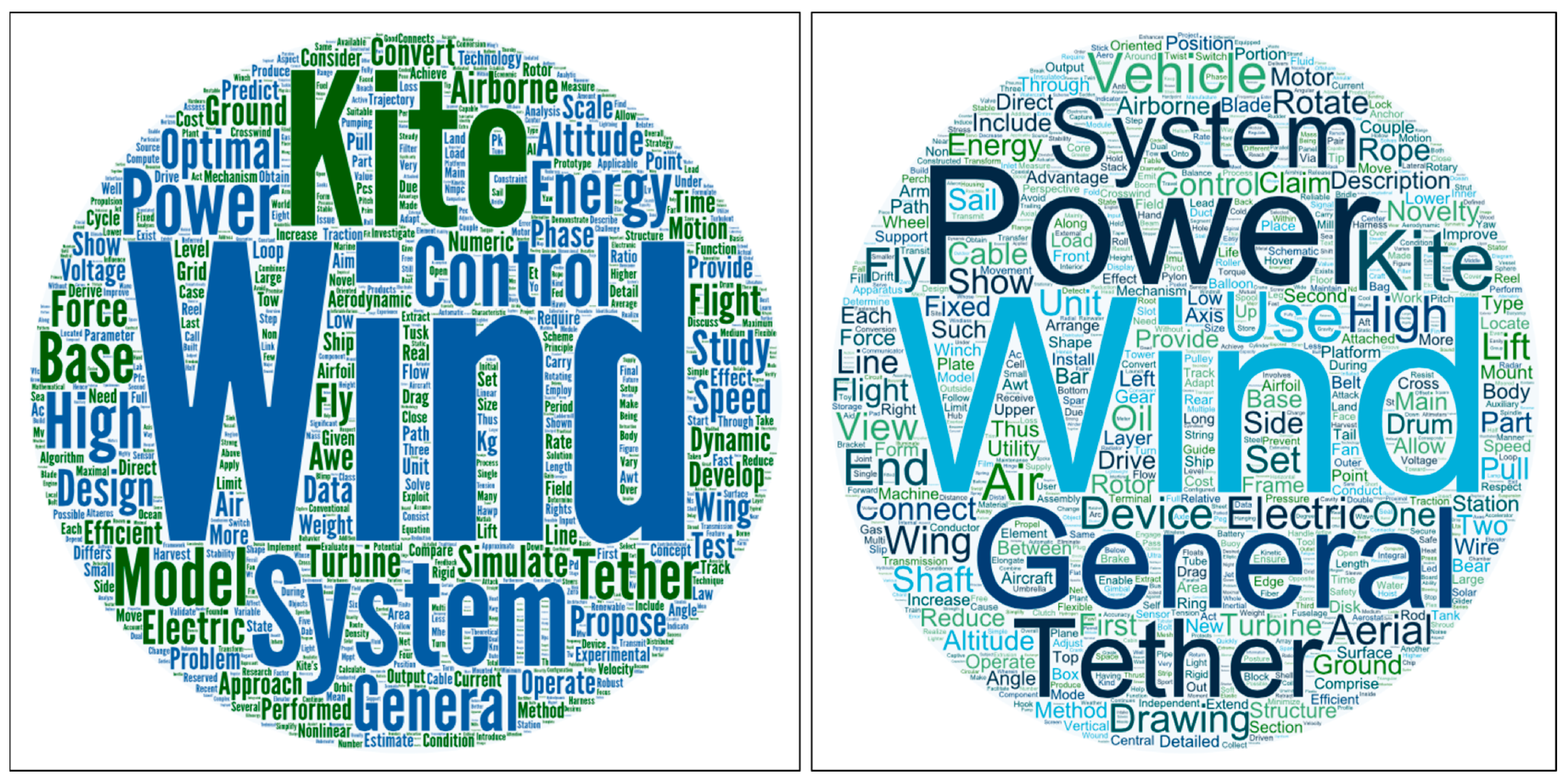
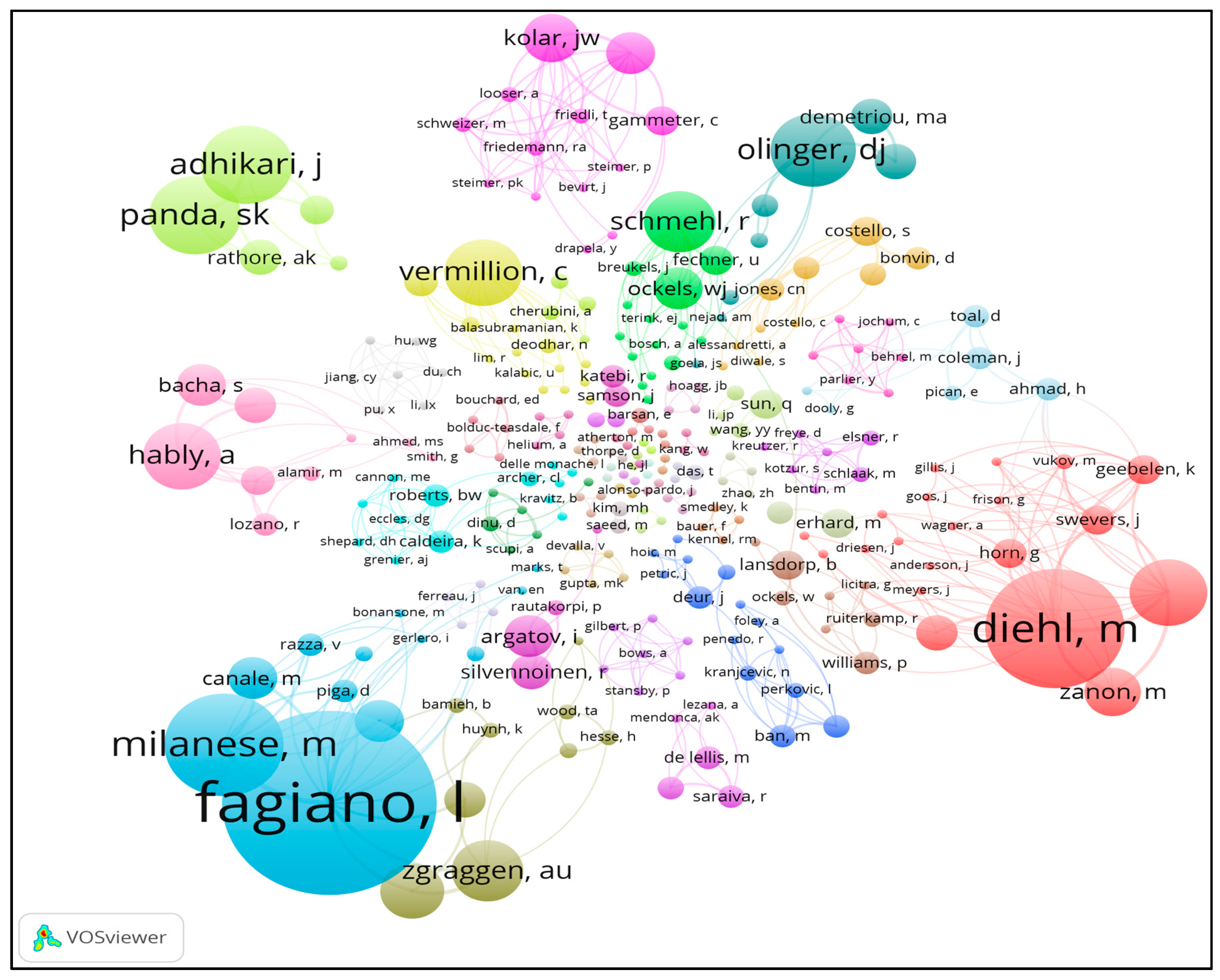
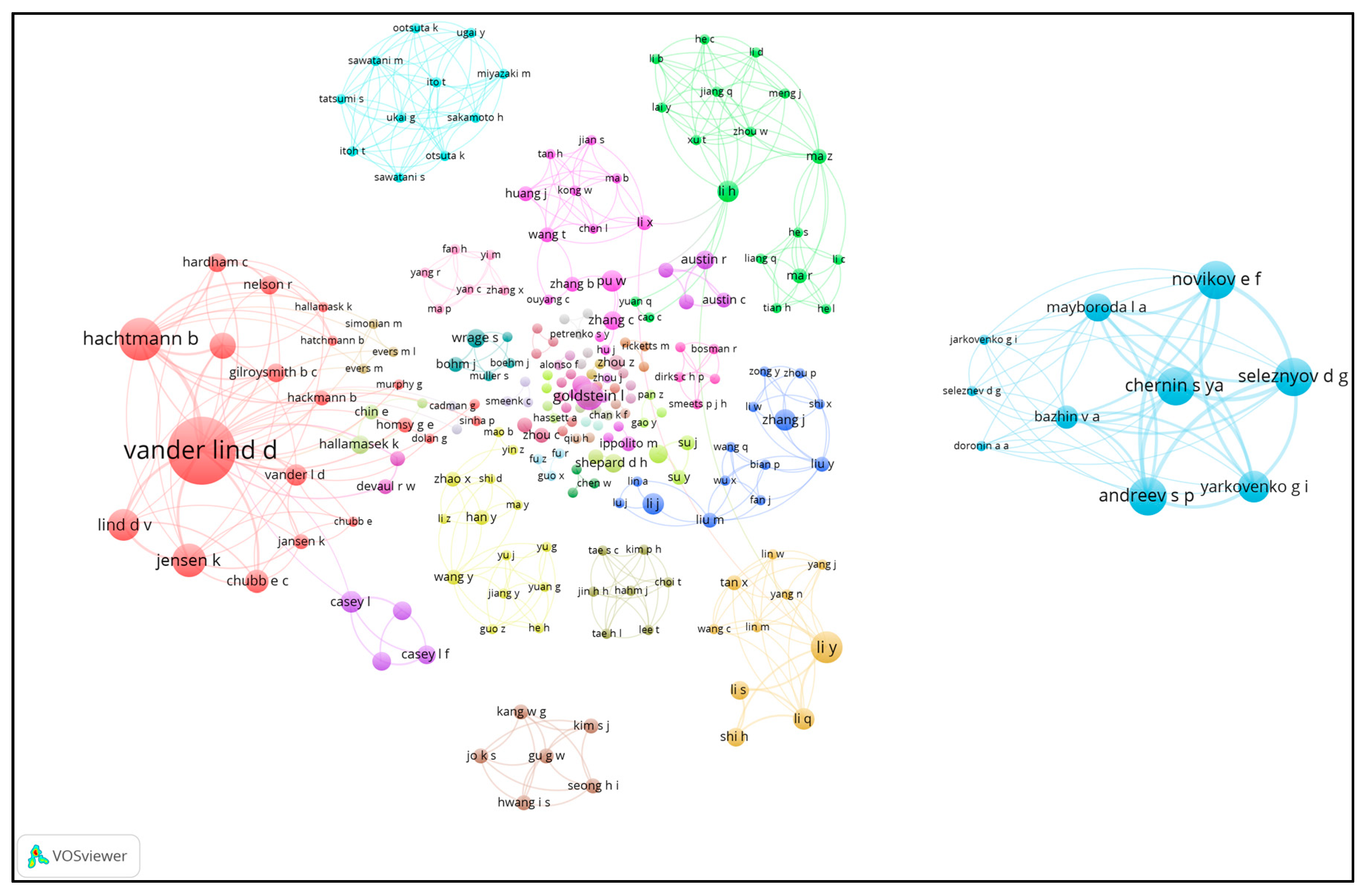
| Keywords | Expression |
|---|---|
| keywords for literature review | TS=(“Airborne Wind Energy”) OR TS=(“Airborne Wind Power”) OR TS=(“High Altitude Wind Energy”) OR TS=(“High Altitude Wind Power”) OR TS=(“Kite wind generator$”) OR TS=(“kite wind energy”) OR TS=(“Crosswind kite$”) OR TS=(“Airborne Wind Turbine$”) OR TS=(“Flying Electric Generator$”) OR TS=(“Kite power”) OR TS=(“Kite energy”) OR TS=(“Pumping kite$”) OR TS=(“Lighter-Than-Air Wind Energy System$”) OR TS=(“Kite model$”) OR TS=(“tethered undersea kite$”) OR TS=(“Kite-Based Wind Energy”) OR TS=(“kite wind power”) OR TS=(“Kite-Powered System$”) OR TS=(“Kite towed ship”) OR TS=(“crosswind towing”) OR SO=(“Airborne Wind Energy”) OR TS=(Parawing AND energy) OR (TS=(Kite) AND TS=(“ship propulsion”)) OR (TS=(“Wind Power”) AND TS=(“flying kite$”)) OR (TS=(“kite”) AND TS=(“tracking control”)) OR (TS=(“kite”) AND TS=(“flight control”)) OR (TS=(“Kite generator”) NOT DO=(“10.1007/s00145-015-9206-4”)) OR (TS=(“Towing kite$” AND “wind energy”)) OR (TS=(“Kite system$”) AND TS=(“Wind energy”)) OR (TS=(“Kite system$”) AND TS=(“Power Generating”)) OR (TS=(“Power Kite$”) AND TS=(“Wind Energy”)) OR (TS=(“Tethered Airfoil$”) AND TS=(“Wind Energy”)) OR (TS=(“kite system”) AND TS=(wind) NOT DO=(10.1007/BF00123534)) OR (TS=(kite) AND AU=(“Creighton, Robert”)) OR (TS=(Laddermill) AND TS=(kite)) OR DO=(“10.2514/3.48003”) OR DO=(“10.1016/0167-6105(85)90015-7”) OR DO=(“10.1016/j.apenergy.2013.07.026”) OR DO=(“10.2514/1.31604”) OR DO=(“10.1002/rnc.1210”) |
| keywords of the search for patents | TS=(“Airborne Wind Energy”) OR TS=(“Airborne Wind Power”) OR TS=(“High Altitude Wind Energy”) OR TS=(“High Altitude Wind Power”) OR TS=(“Kite wind generator$”) OR TS=(“kite wind energy”) OR TS=(“Crosswind kite$”) OR TS=(“Airborne Wind Turbine$”) OR TS=(“Flying Electric Generator$”) OR TS=(“Kite power”) OR TS=(“Kite energy”) OR TS=(“Pumping kite$”) OR TS=(“Lighter-Than-Air Wind Energy System$”) OR TS=(“Kite model$”) OR TS=(“tethered undersea kite$”) OR TS=(“Kite-Based Wind Energy”) OR TS=(“kite wind power”) OR TS=(“Kite-Powered System$”) OR TS=(“Kite towed ship”) OR TS=(“crosswind towing”) OR TS=(“Parawing AND energy”) TS=(“Airborne Wind Energy”) OR TS=(“Airborne Wind Power”) OR TS=(“High Altitude Wind Energy”) OR TS=(“High Altitude Wind Power”) OR TS=(“Kite wind generator$”) OR TS=(“kite wind energy”) OR TS=(“Crosswind kite$”) OR TS=(“Airborne Wind Turbine$”) OR TS=(“Flying Electric Generator$”) OR TS=(“Kite power”) OR TS=(“Kite energy”) OR TS=(“Pumping kite$”) OR TS=(“Lighter-Than-Air Wind Energy System$”) OR TS=(“Kite model$”) OR TS=(“tethered undersea kite$”) OR TS=(“Kite-Based Wind Energy”) OR TS=(“kite wind power”) OR TS=(“Kite-Powered System$”) OR TS=(“Kite towed ship”) OR TS=(“crosswind towing”) OR TS=(“Parawing AND energy”) OR TS=(“Laddermill”) OR TS=(“flying kite$”) |
| Document Type | Count | (%) | Cumulative (%) |
|---|---|---|---|
| Patents | 238 | 49.9 | 49.9 |
| Proceedings paper | 118 | 24.7 | 74.6 |
| Article | 81 | 17.0 | 91.6 |
| Book Chapter | 35 | 7.3 | 99.0 |
| Article; Proceedings paper | 4 | 0.8 | 99.8 |
| Review | 1 | 0.2 | 100.0 |
| Total | 477 | 100.0 |
| Sample References | Citation | Sample Articles | Citation |
|---|---|---|---|
| Loyd, ML, 1980 | 98 | Loyd, ML, 1980 | 98 |
| Canale, M; Fagiano, L; Milanese, M, 2010 | 60 | Canale, M; Fagiano, L; Milanese, M, 2010 | 60 |
| Ilzhoer, A; Houska, B; Diehl, M, 2007 | 57 | Ilzhoer, A; Houska, B; Diehl, M, 2007 | 57 |
| Williams, P; Lansdorp, B; Ockels, W, 2008 | 55 | Williams, P; Lansdorp, B; Ockels, W, 2008 | 55 |
| Archer, CL; Caldeira, K, 2009 | 43 | Archer, CL; Caldeira, K, 2009 | 43 |
| Argatov, I; Rautakorpi, P; Silvennoinen, R, 2009 | 39 | Argatov, I; Rautakorpi, P; Silvennoinen, R, 2009 | 39 |
| Baayen, JH; Ockels, WJ, 2012 | 37 | Canale, M; Fagiano, L; Milanese, M, 2007 | 37 |
| Canale, M; Fagiano, L; Milanese, M, 2007 | 37 | Baayen, JH; Ockels, WJ, 2012 | 37 |
| Fagiano, L; Milanese, M, 2012 | 34 | Fagiano, L; Milanese, M, 2012 | 34 |
| Fagiano, L; Milanese, M; Piga, D, 2010 | 33 | Fagiano, L; Milanese, M; Piga, D, 2010 | 33 |
| Ahrens, U; Diehl, M; Schmehl, R, 2013 | 30 | Canale, M; Fagiano, L; Milanese, M, 2009 | 28 |
| Canale, M; Fagiano, L; Milanese, M, 2009 | 28 | Roberts, BW; Shepard, DH; Caldeira, K; Cannon, ME; Eccles, DG; Grenier, AJ; Freidin, JF, 2007 | 27 |
| Ockels, W. J., 2001 | 28 | Fagiano, L; Milanese, M; Piga, D, 2012 | 26 |
| Roberts, BW; Shepard, DH; Caldeira, K; Cannon, ME; Eccles, DG; Grenier, AJ; Freidin, JF, 2007 | 27 | Erhard, M; Strauch, H, 2013 | 25 |
| Fagiano, L; Milanese, M; Piga, D, 2012 | 26 | Fagiano, L; Zgraggen, AU; Morari, M; Khammash, M, 2014 | 24 |
| Houska B; Diehl, M, 2007 | 26 | Argatov, I; Silvennoinen, R, 2010 | 18 |
| Erhard, M; Strauch, H, 2013 | 25 | Terink, EJ; Breukels, J; Schmehl, R; Ockels, WJ, 2011 | 17 |
| Fagiano L, 2009 | 25 | Fagiano, L; Huynh, K; Bamieh, B; Khammash, M, 2014 | 16 |
| Fagiano, L; Zgraggen, AU; Morari, M; Khammash, M, 2014 | 24 | Jehle, C; Schmehl, R, 2014 | 16 |
| Houska, B; Diehl, M, 2006 | 22 | Fletcher, CAJ; Roberts, BW, 1979 | 13 |
© 2017 by the authors. Licensee MDPI, Basel, Switzerland. This article is an open access article distributed under the terms and conditions of the Creative Commons Attribution (CC BY) license (http://creativecommons.org/licenses/by/4.0/).
Share and Cite
Mendonça, A.K.d.S.; Vaz, C.R.; Lezana, Á.G.R.; Anacleto, C.A.; Paladini, E.P. Comparing Patent and Scientific Literature in Airborne Wind Energy. Sustainability 2017, 9, 915. https://doi.org/10.3390/su9060915
Mendonça AKdS, Vaz CR, Lezana ÁGR, Anacleto CA, Paladini EP. Comparing Patent and Scientific Literature in Airborne Wind Energy. Sustainability. 2017; 9(6):915. https://doi.org/10.3390/su9060915
Chicago/Turabian StyleMendonça, Anny Key de Souza, Caroline Rodrigues Vaz, Álvaro Guillermo Rojas Lezana, Cristiane Alves Anacleto, and Edson Pacheco Paladini. 2017. "Comparing Patent and Scientific Literature in Airborne Wind Energy" Sustainability 9, no. 6: 915. https://doi.org/10.3390/su9060915





